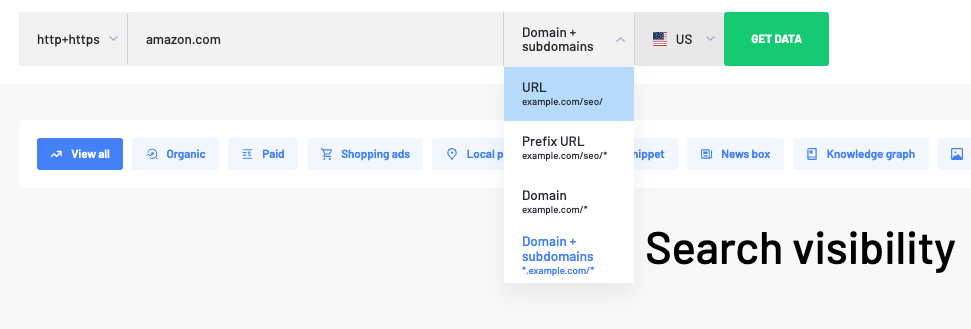With Website Profiler, you can quickly get a complete picture of a website’s online presence. You can see insights into the domain’s organic and paid search traffic and learn more about its top performing pages. It’s a perfect tool for competitor analysis or your link building efforts.
To access the Website Profiler section, use this URL: https://www.marketingminer.com/en/profiler
Try Website Profiler now:
What data you can analyze in Website Profiler
Website Profiler can provide tons of useful insights into a competitor’s domain or specific web pages in no time. Simply enter a URL and select on which level you want to analyze data:
- URL – enter a specific URL, for example, https://www.marketingminer.com/en/blog and you will get the data for this specific URL only.
- Prefix URL – enter a specific URL, and you will get data about all subpages that contain the URL prefix used for data input. For example, Prefix URL https://www.marketingminer.com/en/blog results include links such as https://www.marketingminer.com/en/blog/wordpress-plugin-v-1-0-launched.html
- Domain – in this case, enter a domain or subdomain, for example, www.amazon.com, to get all information about the specific domain or subdomain.
- Domain + subdomain – enter a domain, and you will get data about the whole website and all its subdomains. For example, for domain amazon.com, the results will include data for music.amazon.com too.

What data can you get with a Website Profiler?
With Website Profiler, you will be able to analyze the following data:
- Analysis of specific domains, URLs (or their prefixes) – A quick overview of the overall search engine presence of any URL or domain – estimated organic and paid traffic, ranking keywords, … For more information visit Search visibility.
- Analysis of website visibility in various SERP features – In total, we detect 11 features and website visibility, including the estimated website traffic that comes from these features. The 11 SERP features are: Organic, Paid, Shopping ads, Local pack, Featured snippets, News box, Knowledge graph, Images, Videos, People also ask, Find results on.
- Estimated Traffic change – Detailed information is available in the traffic history graph, which shows the evolution of estimated monthly traffic and estimated search visibility of different SERP features linking to the website.
- Top performing pages and subdomains – With a single click, you can get detailed data on the top landing pages or subdomains that drive the most traffic to the competitor’s website, including the specific keywords they target. For more information, see Top pages and Top subdomains.
- Keyword cannibalization – The cannibalization feature helps you determine if you have way too many identical or similar keywords spread throughout the content of your website. The most important thing in this section is to find true cannibalization issues, which means that different pages on your site are targeting the same keywords and fulfilling the same or very similar intent. More information is available here: https://help.marketingminer.com/en/article/cannibalization/.
- Competing domains and pages – The competition section is useful for discovering domains or pages (URLs) that often compete with the website the most in organic search results.
- Content Gap Analysis – Data on the keywords that your competitors cover (that bring them traffic) but that you do not yet cover. Use this analysis to enrich your future content strategy with these keywords and cover them with new landing pages (category, blog post, product page).
What data does the Website Profiler use?
Website Profiler collects data from Google search results for the most searched keywords, and also collects keyword search volume data from the internal Marketing Miner database, which collects information from the following sources on a daily basis:
- Historical clickstream data
- Google Ads (Keyword Planner) search volume
- Google Trends to estimate how the keyword search volume evolves compared to other keywords
- Google Suggest
After that, all the collected data is used as input to the regressive neural network, which uses it to estimate the real search volume for the keywords. Marketing Miner then recalculates the real keyword search volume for each month. Thus, the output for the user includes the exact search volume for a particular keyword.
